Spatio-Temporal Dynamics and Physico-Hydrological Trends in Rainfall, Runoff and Land Use in Paraíba Watershed
Abstract
1. Introduction
2. Materials and Methods
2.1. Study Area
2.2. Open Access Fluviometric and Pluviometric Data
2.3. Satellite-Derived Data Available (MapBiomas Brazil)
2.4. Mann-Kendall Test
2.5. Statistical and Multivariate Data Analysis
3. Results
3.1. Temporal Analysis of Land Use in the Paraíba Watershed
3.2. Temporal Analysis of Rainfall
3.3. Temporal Analysis of Runoff Stations in the Paraíba Watershed
3.4. Multivariate Analysis of Rainfall, Runoff and Land Use
4. Discussion
4.1. Temporal Analysis of Land Use
4.2. Temporal Analysis of Rainfall
4.3. Temporal Analysis of Runoff Stations
4.4. Multivariate Analysis of Rainfall, Runoff and Land Use
5. Conclusions
Author Contributions
Funding
Data Availability Statement
Acknowledgments
Conflicts of Interest
References
- Shukla, P.R.; Skea, J.; Slade, R.; Al Khourdajie, A.; van Diemen, R.; McCollum, D.; Pathak, M.; Some, S.; Vyas, P.; Fradera, R.; et al. Climate Change 2022: Mitigation of Climate Change; Contribution of Working Group III to the Sixth Assessment Report of the Intergovernmental Panel on Climate Change; Cambridge University Press: Cambridge, UK; New York, NY, USA, 2022. [Google Scholar] [CrossRef]
- de Queiroz, M.G.; da Silva, T.G.F.; Zolnier, S.; de Souza, C.A.A.; de Souza, L.S.B.; do Nascimento Araújo, G.; da Rosa Ferraz Jardim, A.M.; de Moura, M.S.B. Partitioning of Rainfall in a Seasonal Dry Tropical Forest. Ecohydrol. Hydrobiol. 2020, 20, 230–242. [Google Scholar] [CrossRef]
- de Medeiros, F.J.; de Oliveira, C.P. Assessment of Dry and Heavy Rainfall Days and Their Projected Changes over Northeast Brazil in Coupled Model Intercomparison Project Phase 6 Models. Int. J. Climatol. 2022, 42, 8665–8686. [Google Scholar] [CrossRef]
- Avalon Cullen, C.; Al Suhili, R. Assessing Rainfall Variability in Jamaica Using CHIRPS: Techniques and Measures for Persistence, Long and Short-Term Trends. Geographies 2023, 3, 375–397. [Google Scholar] [CrossRef]
- Patakamuri, S.K.; Muthiah, K.; Sridhar, V. Long-Term Homogeneity, Trend, and Change-Point Analysis of Rainfall in the Arid District of Ananthapuramu, Andhra Pradesh State, India. Water 2020, 12, 211. [Google Scholar] [CrossRef]
- Khan, N.; Pour, S.H.; Shahid, S.; Ismail, T.; Ahmed, K.; Chung, E.; Nawaz, N.; Wang, X. Spatial Distribution of Secular Trends in Rainfall Indices of Peninsular Malaysia in the Presence of Long-term Persistence. Meteorol. Appl. 2019, 26, 655–670. [Google Scholar] [CrossRef]
- Pan, X.; Li, T.; Sun, Y.; Zhu, Z. Cause of Extreme Heavy and Persistent Rainfall over Yangtze River in Summer 2020. Adv. Atmos. Sci. 2021, 38, 1994–2009. [Google Scholar] [CrossRef]
- Ogunrinde, A.T.; Oguntunde, P.G.; Akinwumiju, A.S.; Fasinmirin, J.T. Analysis of Recent Changes in Rainfall and Drought Indices in Nigeria, 1981–2015. Hydrol. Sci. J. 2019, 64, 1755–1768. [Google Scholar] [CrossRef]
- da Silva, J.L.B.; de Albuquerque Moura, G.B.; da Silva, M.V.; de Oliveira-Júnior, J.F.; da Rosa Ferraz Jardim, A.M.; Refati, D.C.; da Cunha Correia Lima, R.; de Carvalho, A.A.; Ferreira, M.B.; de Brito, J.I.B.; et al. Environmental Degradation of Vegetation Cover and Water Bodies in the Semiarid Region of the Brazilian Northeast via Cloud Geoprocessing Techniques Applied to Orbital Data. J. S. Am. Earth Sci. 2023, 121, 104164. [Google Scholar] [CrossRef]
- de Oliveira Júnior, J.G.; Lopes, P.M.O.; Nascimento, C.R.; de Albuquerque Moura, G.B.; de Oliveira Júnior, J.F. Space-Temporal Detection of Environmental Changes in the Brazilian Semiarid through Google Earth Engine and GIS. J. S. Am. Earth Sci. 2023, 127, 104403. [Google Scholar] [CrossRef]
- Souza, C.M., Jr.; Shimbo, J.Z.; Rosa, M.R.; Parente, L.L.; Alencar, A.A.; Rudorff, B.F.T.; Hasenack, H.; Matsumoto, M.; Ferreira, L.G.; Souza-Filho, P.W.M.; et al. Reconstructing Three Decades of Land Use and Land Cover Changes in Brazilian Biomes with Landsat Archive and Earth Engine. Remote Sens. 2020, 12, 2735. [Google Scholar] [CrossRef]
- MapBiomas Coleção 7.1 Da Série Anual de Mapas de Cobertura e Uso Da Terra Do Brasil. Available online: https://mapbiomas.org/colecoes-mapbiomas-1?cama_set_language=pt-BR (accessed on 1 July 2023).
- Measho, S.; Chen, B.; Trisurat, Y.; Pellikka, P.; Guo, L.; Arunyawat, S.; Tuankrua, V.; Ogbazghi, W.; Yemane, T. Spatio-Temporal Analysis of Vegetation Dynamics as a Response to Climate Variability and Drought Patterns in the Semiarid Region, Eritrea. Remote Sens. 2019, 11, 724. [Google Scholar] [CrossRef]
- de Sousa, J.Y.B.; Velozo, A.L.S.; Pereira, J.R.; Santos, G.F.; Araújo, S.R.D.; de Araújo, S.N.R. Detecção Temporal de Impactos em Áreas Conflitantes e Uso Dos Recursos Hídricos No Semiárido Da Paraíba. Rev. Geociências Nordeste 2020, 6, 24–31. [Google Scholar] [CrossRef]
- da Rosa Ferraz Jardim, A.M.; da Silva, M.V.; Silva, A.R.; dos Santos, A.; Pandorfi, H.; de Oliveira-Júnior, J.F.; de Lima, J.L.M.P.; de Souza, L.S.B.; do Nascimento Araújo Júnior, G.; Lopes, P.M.O.; et al. Spatiotemporal Climatic Analysis in Pernambuco State, Northeast Brazil. J. Atmos. Sol. Terr. Phys. 2021, 223, 105733. [Google Scholar] [CrossRef]
- da Silva Morais, A.C.; Barbosa, N.F.M. Modelagem de Dados Volumétricos do Açude Epitácio Pessoa (Boqueirão). Res. Soc. Dev. 2022, 11, e409111133772. [Google Scholar] [CrossRef]
- de Oliveira, L.N.; de Aquino, C.M.S. Dinâmica Temporal Do Uso e Cobertura Da Terra Na Fronteira Agrícola Do Matopiba: Análise Na Sub-Bacia Hidrográfica Do Rio Gurguéia-Piauí. REVISTA EQUADOR 2020, 9, 317–333. [Google Scholar] [CrossRef]
- Ayele, H.A.; Aga, A.O.; Belayneh, L.; Wanjala, T.W. Hydrological Responses to Land Use/Land Cover Changes in Koga Watershed, Upper Blue Nile, Ethiopia. Geographies 2023, 3, 60–81. [Google Scholar] [CrossRef]
- Agência Nacional de Águas. HidroWeb: Sistemas de Informações Hidrológicas. 2023. Available online: https://www.snirh.gov.br/hidroweb-mobile/mapa (accessed on 1 July 2023).
- Calegario, A.; Althoff, D. Access to the Brazilian National Water Agency (Agência Nacional de Águas) Hydrological Data 2023. Available online: https://dadosabertos.ana.gov.br/ (accessed on 1 July 2023).
- Hasan, I.; Liu, W.; Xu, C. Monitoring and Analyzing the Seasonal Wetland Inundation Dynamics in the Everglades from 2002 to 2021 Using Google Earth Engine. Geographies 2023, 3, 161–177. [Google Scholar] [CrossRef]
- Mann, H.B. Nonparametric Tests Against Trend. Econometrica 1945, 13, 245. [Google Scholar] [CrossRef]
- Kendall, M.G. Rank Correlation Methods. London, 2nd ed.; Griffin: London, UK, 1975. [Google Scholar]
- das Graças Silva, T.F.; Beltrán, D.; de Oliveira Nascimento, N.; Rodríguez, J.P.; Mancipe-Muñoz, N. Assessing Major Drivers of Runoff Water Quality Using Principal Component Analysis: A Case Study from a Colombian and a Brazilian Catchments. Urban Water J. 2022, 2022, 1–13. [Google Scholar] [CrossRef]
- Yu, Y.; Zhu, R.; Ma, D.; Liu, D.; Liu, Y.; Gao, Z.; Yin, M.; Bandala, E.R.; Rodrigo-Comino, J. Multiple Surface Runoff and Soil Loss Responses by Sandstone Morphologies to Land-Use and Precipitation Regimes Changes in the Loess Plateau, China. Catena 2022, 217, 106477. [Google Scholar] [CrossRef]
- Hu, T.; Wu, F.; Zhang, X. Rainfall–Runoff Modeling Using Principal Component Analysis and Neural Network. Hydrol. Res. 2007, 38, 235–248. [Google Scholar] [CrossRef]
- Wold, S.; Esbensen, K.; Geladi, P. Principal Component Analysis. Chemom. Intell. Lab. Syst. 1987, 2, 37–52. [Google Scholar] [CrossRef]
- dos Santos Souza Marinho, R.; Duro, R.L.S.; de Oliveira Mota, M.T.; Hunter, J.; Diaz, R.S.; Kawakubo, F.S.; Komninakis, S.V. Environmental Changes and the Impact on the Human Infections by Dengue, Chikungunya and Zika Viruses in Northern Brazil, 2010–2019. Int. J. Environ. Res. Public Health 2022, 19, 12665. [Google Scholar] [CrossRef] [PubMed]
- R Core Team: R: A Language and Environment for Statistical Computing; R Foundation for Statistical Computing: Vienna, Austria, 2023; Available online: https://www.R-project.org/ (accessed on 1 July 2023).
- Gebremeskel Haile, G.; Tang, Q.; Leng, G.; Jia, G.; Wang, J.; Cai, D.; Sun, S.; Baniya, B.; Zhang, Q. Long-Term Spatiotemporal Variation of Drought Patterns over the Greater Horn of Africa. Sci. Total Environ. 2020, 704, 135299. [Google Scholar] [CrossRef]
- Da Silva Seabra, V.; Xavier, R.A.; Damasceno, J.; Da Conceição Dornellas, P. Mapeamento Do Uso e Cobertura Do Solo Da Bacia Do Rio Taperoá: Região Semiárida Do Estado Da Paraíba. Caminhos Geogr. 2014, 15, 127–137. [Google Scholar] [CrossRef]
- Francisco, P.R.M.; Silva, V.F.; Ribeiro, G.D.N.; Santos, D.; Ayres, G.D.J. Potencial de Expansão Da Irrigação Em Bacia Hidrográfica Da Região Do Médio Curso Do Rio Paraíba. POLÊM!CA 2023, 21, 146–165. [Google Scholar] [CrossRef]
- de Oliveira Simões, J.P.; dos Santos, S.L. Análise Dos Indicadores de Desempenho de Áreas Irrigadas No Município de Boqueirão, Estado Da Paraíba. Rev. Verde Agroecol. Desenvolv. Sustentável 2014, 9, 356–361. [Google Scholar]
- de Andrade, A.R.; de Lima, P.R.C.; de Oliveira, J.V.P.; Lucena, D.B. Análise Da Relação Entre Precipitação e Volume Nas Sub-Bacias Contribuintes Para o Açude Epitácio Pessoa. Rev. Bras. Climatol. 2019, 25, 719–736. [Google Scholar] [CrossRef][Green Version]
- Farto, C.D.; da Silva, T.C. Variações Da Qualidade Da Água de Chuva e de Açudes Armazenada Em Cisternas Em Municípios Do Semiárido Do Estado Da Paraíba. Eng. Sanit. Ambient. 2020, 25, 859–871. [Google Scholar] [CrossRef]
- Correia, I.; Correia, I.M.G.; da Silva, J.B. Águas Da Transposição Do Rio São Francisco Na Paraíba: Esgotos e Inviabilidades Municipais. AMBIÊNCIA 2021, 16, 799–816. [Google Scholar]
- Fernandes, M.M.; de Moura Fernandes, M.R.; Garcia, J.R.; Matricardi, E.A.T.; de Souza Lima, A.H.; de Araújo Filho, R.N.; Filho, R.R.G.; Piscoya, V.C.; Piscoya, T.O.F.; Filho, M.C. Land Use and Land Cover Changes and Carbon Stock Valuation in the São Francisco River Basin, Brazil. Environ. Chall. 2021, 5, 100247. [Google Scholar] [CrossRef]
- Rafiei-Sardooi, E.; Azareh, A.; Joorabian Shooshtari, S.; Parteli, E.J.R. Long-Term Assessment of Land-Use and Climate Change on Water Scarcity in an Arid Basin in Iran. Ecol. Model. 2022, 467, 109934. [Google Scholar] [CrossRef]
- Srinivas, R.; Das, B.; Singhal, A. Integrated Watershed Modeling Using Interval Valued Fuzzy Computations to Enhance Watershed Restoration and Protection at Field-Scale. Stoch. Environ. Res. Risk Assess. 2022, 36, 1429–1445. [Google Scholar] [CrossRef]
- Rufino, P.R.; Gücker, B.; Faramarzi, M.; Boëchat, I.G.; da Silva Cardozo, F.; Santos, P.R.; Zanin, G.D.; Mataveli, G.; Pereira, G. Evaluation of the SWAT Model for the Simulation of Flow and Water Balance Based on Orbital Data in a Poorly Monitored Basin in the Brazilian Amazon. Geographies 2022, 3, 1–18. [Google Scholar] [CrossRef]
- Pereira, S.B.; Pruski, F.F.; da Silva, D.D.; Ramos, M.M. Estudo Do Comportamento Hidrológico Do Rio São Francisco e Seus Principais Afluentes. Rev. Bras. Eng. Agrícola Ambient. 2007, 11, 615–622. [Google Scholar] [CrossRef]
- da Costa Silva, J.F.C.B.; da Silva, R.M.; Santos, C.A.G.; Silva, A.M.; Vianna, P.C.G. Analysis of the Response of the Epitácio Pessoa Reservoir (Brazilian Semiarid Region) to Potential Future Drought, Water Transfer and LULC Scenarios. Nat. Hazards 2021, 108, 1347–1371. [Google Scholar] [CrossRef]
- Correia, I.M.G.; de Souza, B.H.; Moura, D.C.; de Souza, Y.G. Mata Ciliar, Conservação e Sustentabilidade, Fundamentos Da Importância Para o Semiárido Paraibano: Estudo de Caso No Alto Curso Do Rio Paraíba. Rev. Geociências Nordeste 2019, 5, 41–60. [Google Scholar] [CrossRef]
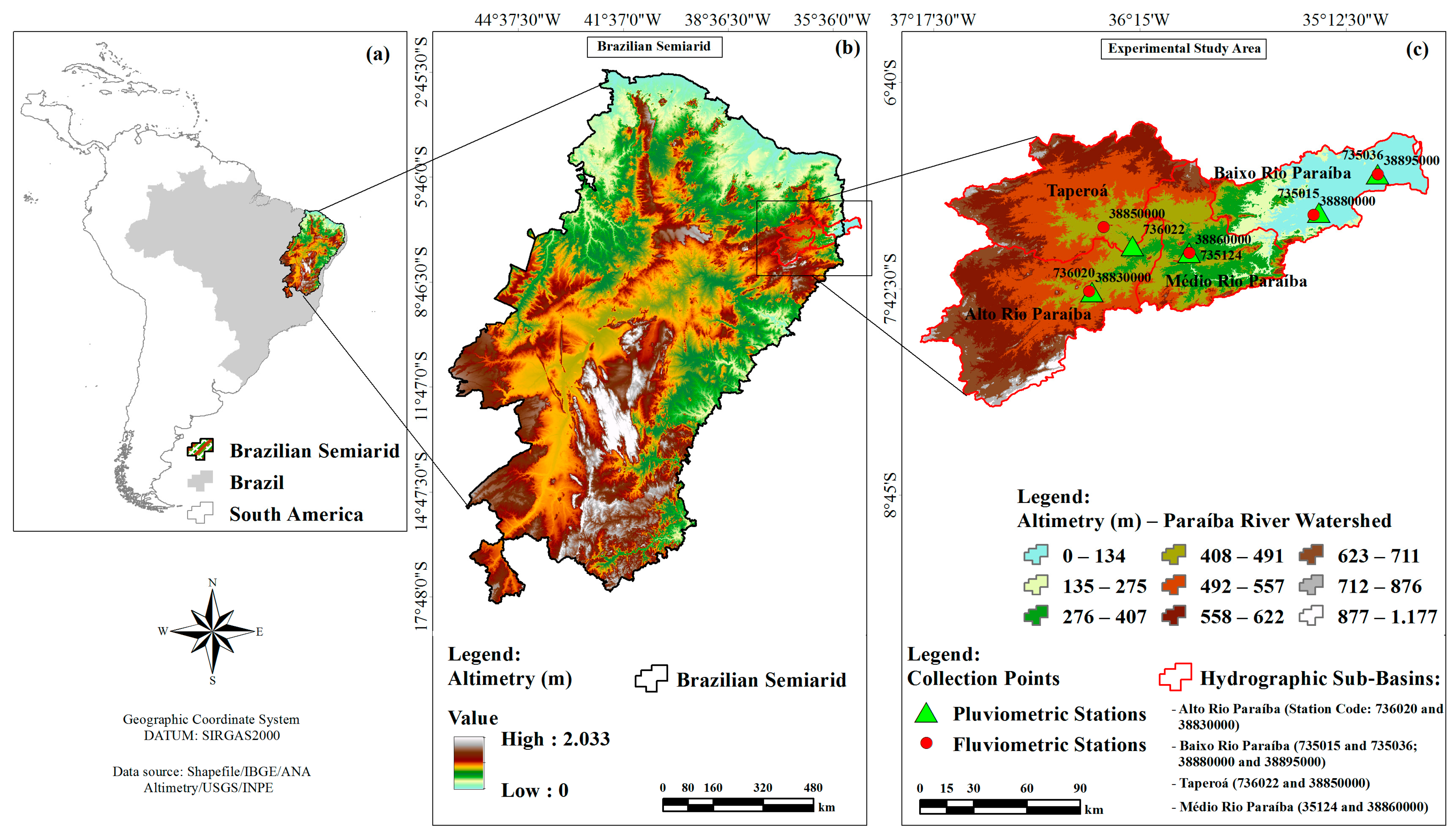
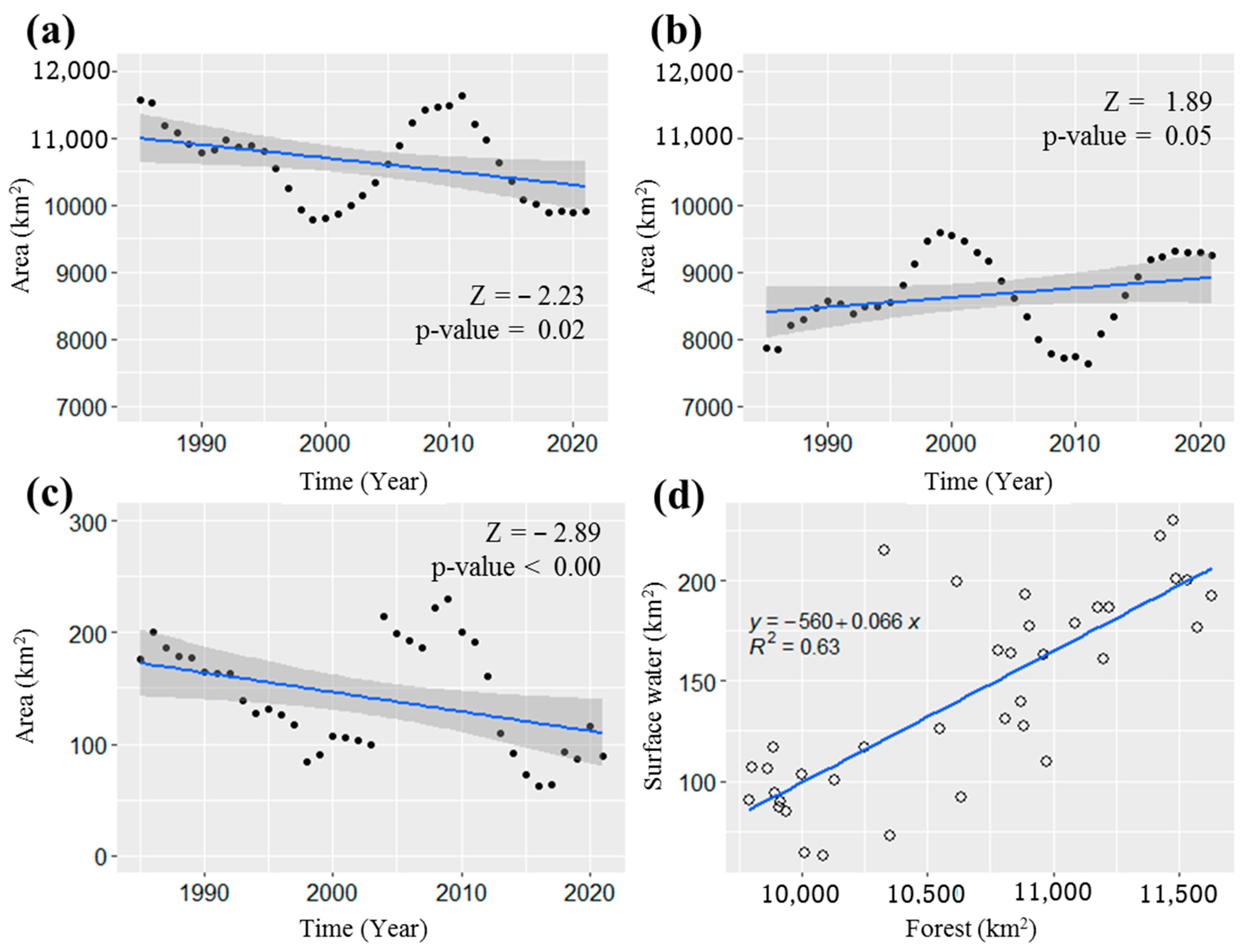
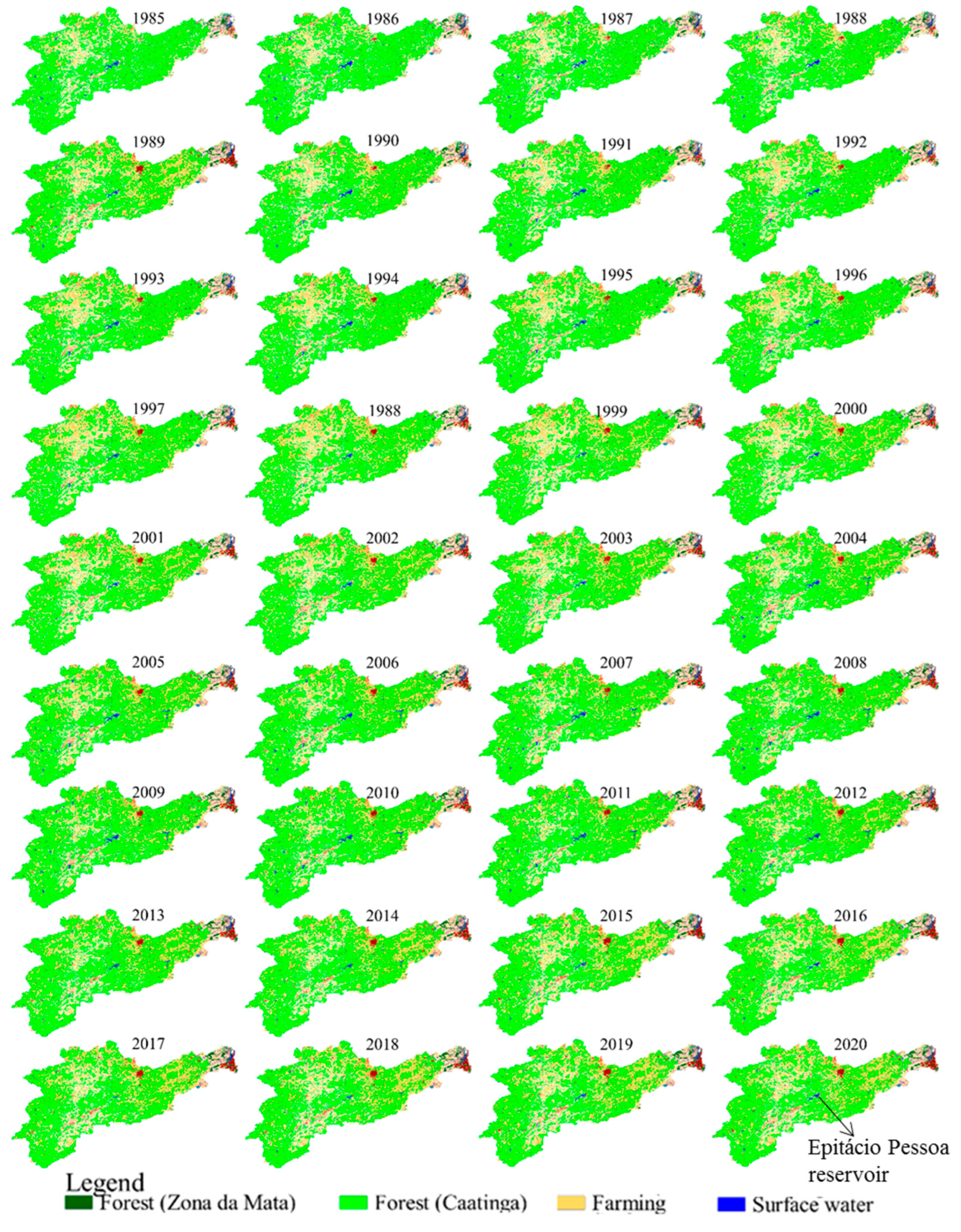
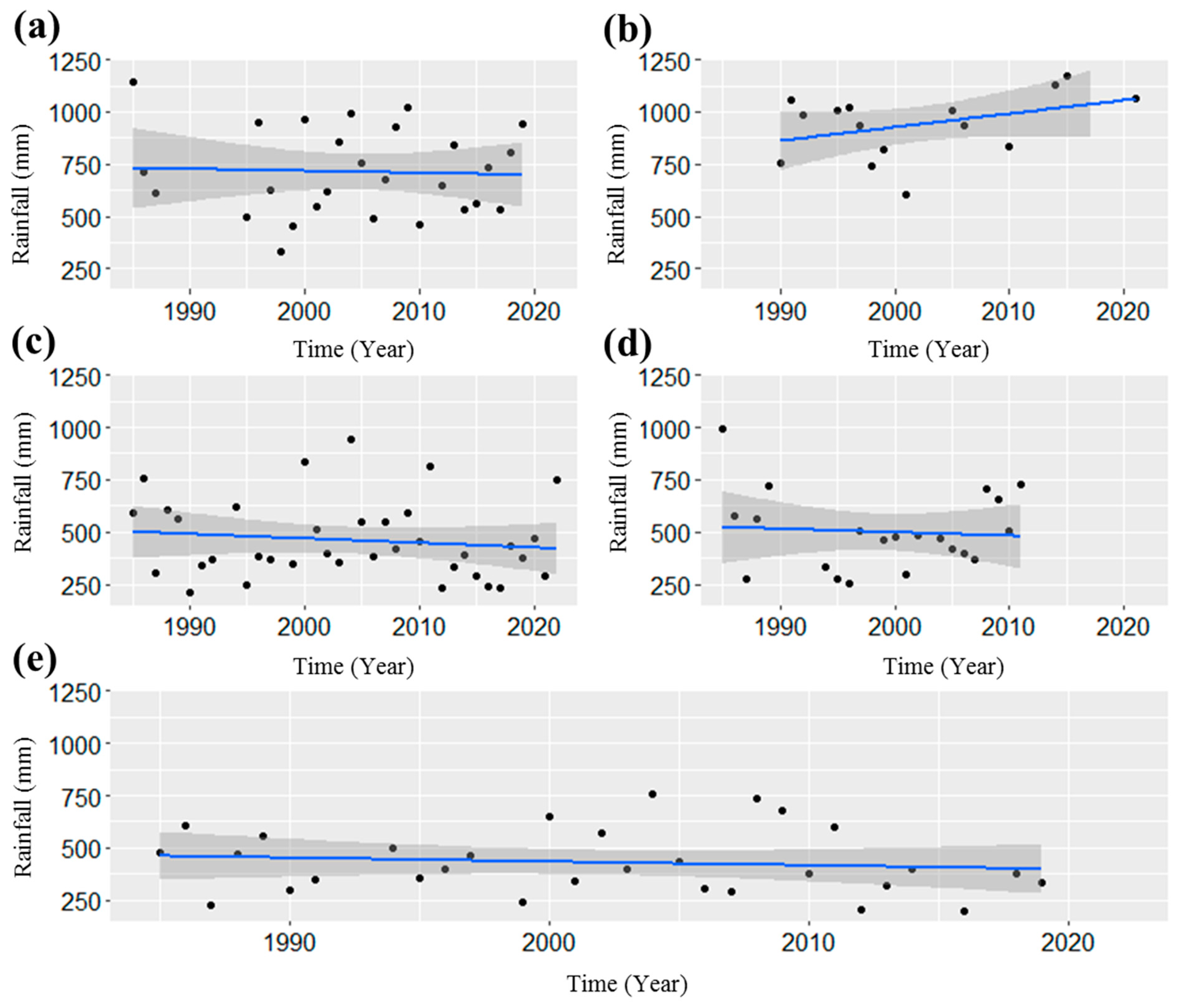
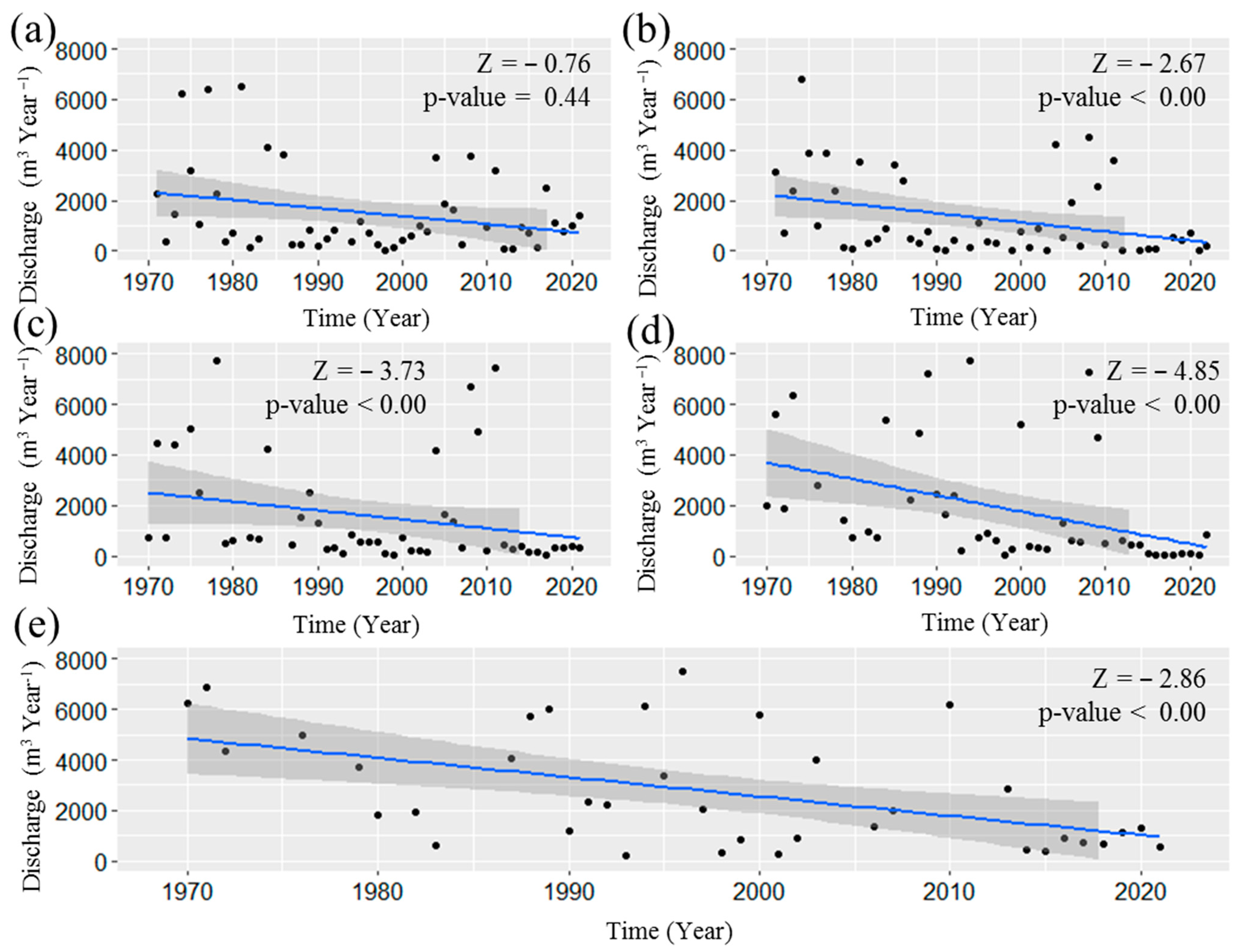

Disclaimer/Publisher’s Note: The statements, opinions and data contained in all publications are solely those of the individual author(s) and contributor(s) and not of MDPI and/or the editor(s). MDPI and/or the editor(s) disclaim responsibility for any injury to people or property resulting from any ideas, methods, instructions or products referred to in the content. |
© 2023 by the authors. Licensee MDPI, Basel, Switzerland. This article is an open access article distributed under the terms and conditions of the Creative Commons Attribution (CC BY) license (https://creativecommons.org/licenses/by/4.0/).
Share and Cite
de Carvalho, A.A.; da Silva, M.J.G.; da Costa Batista, F.R.; Araújo, J.S.; de Assunção Montenegro, A.A.; da Silva, T.G.F.; Almeida, T.A.B.; da Silva, M.V.; Dias, J.; Cavalcante, I.T.R.; et al. Spatio-Temporal Dynamics and Physico-Hydrological Trends in Rainfall, Runoff and Land Use in Paraíba Watershed. Geographies 2023, 3, 714-727. https://doi.org/10.3390/geographies3040038
de Carvalho AA, da Silva MJG, da Costa Batista FR, Araújo JS, de Assunção Montenegro AA, da Silva TGF, Almeida TAB, da Silva MV, Dias J, Cavalcante ITR, et al. Spatio-Temporal Dynamics and Physico-Hydrological Trends in Rainfall, Runoff and Land Use in Paraíba Watershed. Geographies. 2023; 3(4):714-727. https://doi.org/10.3390/geographies3040038
Chicago/Turabian Stylede Carvalho, Ailton Alves, Marcelo José Gama da Silva, Fabiane Rabelo da Costa Batista, Jucilene Silva Araújo, Abelardo Antônio de Assunção Montenegro, Thieres George Freire da Silva, Thayná Alice Brito Almeida, Marcos Vinícius da Silva, Joelma Dias, Iara Tamires Rodrigues Cavalcante, and et al. 2023. "Spatio-Temporal Dynamics and Physico-Hydrological Trends in Rainfall, Runoff and Land Use in Paraíba Watershed" Geographies 3, no. 4: 714-727. https://doi.org/10.3390/geographies3040038
APA Stylede Carvalho, A. A., da Silva, M. J. G., da Costa Batista, F. R., Araújo, J. S., de Assunção Montenegro, A. A., da Silva, T. G. F., Almeida, T. A. B., da Silva, M. V., Dias, J., Cavalcante, I. T. R., & da Silva, J. L. B. (2023). Spatio-Temporal Dynamics and Physico-Hydrological Trends in Rainfall, Runoff and Land Use in Paraíba Watershed. Geographies, 3(4), 714-727. https://doi.org/10.3390/geographies3040038








